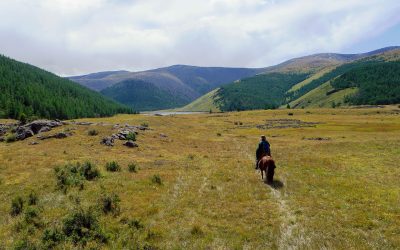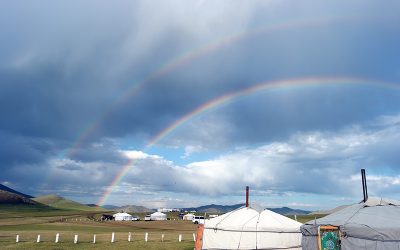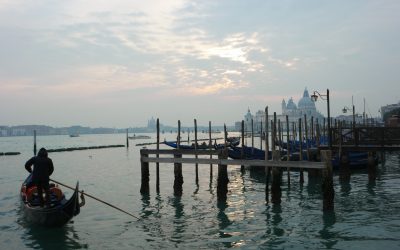This is a very unusual and interesting book, strongly nonconformist to plate tectonics. Storetvedt, Professor of Geophysics at the University of Bergen since 1973, is arguably one of the most distinguished European palaeomagnetists. After and during many plate tectonics based contributions in reputed scientific journals in the earlier years, today he is one of the few diehards who completely dismiss plate tectonics. Storetvedt is the man who, in the mid-seventies, brought about a consciousness of remagnetization problems in palaeomagnetism—remagnetization is a major issue in analytical and experimental palacomagnetism today. Another startling and revolutionary demonstration of Storetvedt a few years ago was that the well-known diverging APW paths for the various continents, usually cited as the ‘ultimate’ evidence for lateral continental drift, do not require or prove Wegenerian-type motions, but are fully explainable by continental rotations in situ, such that a continent rotates around an Euler pole located within it, not outside it. In brief, no palaeomagnetic data ever proved lateral continental drift.
The book launches Storetvedt’s new model of Earth evolution, Global Wrench Tectonics. The book is divided into two parts. In the first, Storetvedt discusses global theories of the past, such as Earth contraction, and argues that plate tectonics is not relevant to the Earth, discussing its fundamental weaknesses and paradoxes. For example, the widespread existence of very old, Precambrian rocks like granites, gneisses and amphibolites in the ocean floors is fatal to plate tectonics, which argues that the ocean floors are no older than ~ 200 million years. These rocks, some of them 80km’ in size, have been dismissed as ice-rafted erratics or ship ballast. India has a very important role to play in global tectonics, and if it has drifted thousands of kilometres from southern latitudes, the strong affinities of its fauna (such as the dinosaurs) with the Eurasian ones cannot be explained. The Glossopteris flora has been much abused as unquestionable evidence for placing India in the Southern Hemisphere as part of an alleged Gondwanaland, but we are never told that the same Glossopteris is also known from Thailand, Burma, Tibet, Siberia and European Russia. If India underthrust Asia from the south and raised the Himalayas, and the Indus-Zangbo ophiolite represents the Tethyan oceanic crust obducted in this process, is it not a curious fact that this ophiolite, which should exist between India and the Himalayan range, actually exists to the north of the Himalayan range? Briefly, there are innumerable questions that plate tectonics has never satisfactorily answered, or even discussed, and Storetvedt therefore argues that plate tectonics is not relevant to the Earth.
In the second part of the book he presents Global Wrench Tectonics, the essence of which can be stated as follows. In its early history the Earth had a pan-global granitic—granulitic crust, which has been variably assimilated by basic magmas from the mantle during geological time, but some undigested remains of continental crust still exist in the ocean basins. (This is the oceanization concept of V. Beloussov.) Due to continual mantle diapirism throughout time and the resulting internal reorganization of mass which changes the Earth’s moment of inertia, the Earth has undergone systematic changes in its spatial orientation (relative to the celestial axis) and changes in its rate of rotation. The planet’s changes of spatial orientation constitute polar wander, and this phenomenon can be demonstrated with palaeoclimate and palaeomagnetic data. For example, from Lower Palaeozoic to mid-Tertiary time the climate of the Arctic and Antarctic regions has changed from tropical to polar (the Lower-Middle Palaeozoic geology of these regions comprises coral reefs, evaporites, red beds and desert sandstones). An exactly opposite palaeoclimatic change (polar to tropical) has been experienced by central Africa. According to Storetvedt, this is simply due to polar wander: the continents have remained where they were, except for mostly minor in situ rotations, but the whole Earth has repeatedly changed its spatial orientation, and thus the climate of the land masses has changed too. Polar wander was actually recognized and cited more than a century ago, not least by Wegener himself, but with the later observations that all continents had differing APW paths, Wegenerian drift (to imply lateral separation) became accepted and polar wander came to be thought unnecessary. As Storetvedt writes, Wegenerian drift was the only solution conceivable then for explaining these diverging APW paths, but his reinterpretations involving in situ rotations (not translations) of the continental masses now remove all paradoxes (such as the glaring paradox involving Africa—Antarctica, which are both surrounded by spreading ridges), and gives new credibility to polar wander too.
In Storetvedt’s model, global tectonics is strongly linked to Earth’s rotation (a parameter that plate tectonics does not even recognize). There seems to have been an overall retardation of the rotation rate throughout time with progressive oceanization, This is consistent with palaeontological data such as fossil shell growth rings, which indicate that the number of days per year has dropped from about 425 in the Lower Palaeozoic to 365 today. Further, in a rotating planet experiencing upwelling of material from the deep interior, the outward mantle currents, chemically eroding the sialic crust, should be expected to have a certain concentration along the equator (due to the greatest centrifugal force acting there). This explains the existence of geosynclines along the time-equivalent (palaeo-)equators. The concept of geosynclines has been discredited by plate tectonics, but the Alpine-Himalayan fold belt, for example, has developed along the Upper Cretaceous—Lower Tertary equator, and the geosynclinal, pre-orogenic stage of fold belts is a natural consequence of mantle diapirism within a rotating body. Other major fold belts such as the Caledonian and Hercynian also formed at the time-equivalent equators, and it is remarkable that these fold belts are becoming progressively younger southwards following the palaeoequator which was itself changing. (It was as late as the uppermost Eocene – Early Oligocene that the equator has moved to its present position.)
By Alpine time the loss of continental crust to the mantle had reached an advanced stage, and as a consequence of planetary rotation the lithosphere became mobile and the continents underwent variable rotations. These mostly minor continental rotations were the result of a certain westward wrenching of the entire global lithosphere, governed by inertia forces, as a natural response to a certain acceleration in the Earth’s rotation (eastward). The new mobilistic system explains the observed discrepancies of palaeomagnetically based apparent polar wander paths, yet the continents have remained fairly stationary with respect to their mantle roots, consistent with and as required by seismic tomography for example. Thus, in the Alpine time Africa and Eurasia performed in situ rotations of ~25° in opposite senses, and this fully explains their post-Precambrian palaeomagnetic discrepancy. The Alpine belt between them is a transpressive structure running close to the (uppermost Cretaceous-Lower Tertiary) equator. India’s northward drift was only one possible interpretation of the palaeomagnetic data (mostly from the Deccan Traps) which were hooked up with the idea of Wegenerian drift and Gondwanaland which was becoming popular then; the palaeomagnetic data can as well be interpreted as indicating an in situ clockwise rotation of India, through~ 135°, at the time of the Cretaceous-Tertiary Boundary, keeping India all the time close to Eurasia and thus consistent with all palaeoclimatological-biogeographical evidence. The Tethys Sea was certainly real and many Himalayan sedimentary sequences are undoubtedly marine (why have they not been subducted?), but it was not an ocean several thousand kilometres wide as pictured by plate tectonics, rather it was a narrow seaway on a sialic basement. The Meyerhoffs wrote long back in 1974: ‘India has been a part of Asia since Proterozoic or earlier time … Interpretations of palaeomagnetic data (the basic premises of which are known to be in error), interpretations of the fracture pattern of the Indian ocean floor (for which there are many possible interpretations), and errors of ignorance, cannot change this geologic fact.’
Coming back to Storetvedt’s model, the mid-ocean ridges are not spreading centres, but made up of innumerable tectonized and metamorphic rocks, they are also Alpine-age transpressive features, though their topographic uplift is much younger. (In this light some recent observations, which demonstrate that asthenospheric flow beneath the ridges is not ridge-transverse but ridge-parallel, are most pertinent.) In Storetvedt’s opinion, major flood volcanism such as the Deccan Traps episode is linked to events of polar wander, and many presumed asteroid-impact structures may similarly have been formed by violent gas explosions-shock events originating in the Earth’s interior itself.
Storetvedt, himself a palaeomagnetics specialist, points out that palaeomagnetic data are not any ‘independent evidence’ that Arthur Holmes expected them to be, but their interpretations are usually governed by the personal beliefs and concepts of the workers. Storetvedt would be very happy to discuss his new model with interested colleagues, and can be contacted at the Institute of Geophysics, University of Bergen, The new theory of Earth evolution seems to have great explanatory and predictive power and answers to many questions, problems and former paradoxes. It links a wide range of geological-geophysical observations into a coherent picture of a new, orderly dynamic Earth, and may indeed be applicable to all the terrestrial planets such as the Moon, Venus and Mars, which are anyhow known to be ‘one-plate’ planets.
The book, a brilliant research work, is also exceptionally well-suited for being a college textbook for geology and geophysics, noting its historical approach, invaluable scientific material and step-by-step treatment of global tectonics issues, with a thousand references and a useful subject index. Teachers will find it an enjoyable and intellectually rewarding exercise to discuss it with their students. So radical and unconventional, and yet so well-meaning and friendly is the book that I have no hesitation in calling it one of the best and most remarkable books in the entire history of geoscience literature. Although it is meant primarily for college students and professionals, it will be of interest to high school teachers, geographers and historians of science as well. In fact, Storetvedt himself takes an active interest in the history and philosophy of science and problems in science teaching.
The book has excellent get-up, with an attractive cover photograph of the Earth and many illustrations that vary in quality from good to excellent. The printing and paper quality are just excellent. The writing style is lucid, but there are certainly several errors of spelling and apparently of grammar distributed all through the book. More serious, I could find a few references cited incorrectly in the text and the bibliography, and some citations in the text are missing in the bibliography. Also, the price of this otherwise extraordinary book will be beyond the individual buying capacity of many inquisitive Indian scientists and students. However, every geology library in India and abroad should have it; every geologist, geophysicist and tectonicist willing to rediscover the real Earth should read it; teachers should teach students from it. I heartily congratulate the author and the publishers on having produced the book, and hope that it receives the very wide readership which it so richly deserves. After all, the clock has turned full circle, and this is the new revolution in the Earth sciences.
H. C. SHETH
Department of Earth Sciences,
Indian Institute of Technology,
Powai,
Bombay 400 076, India




